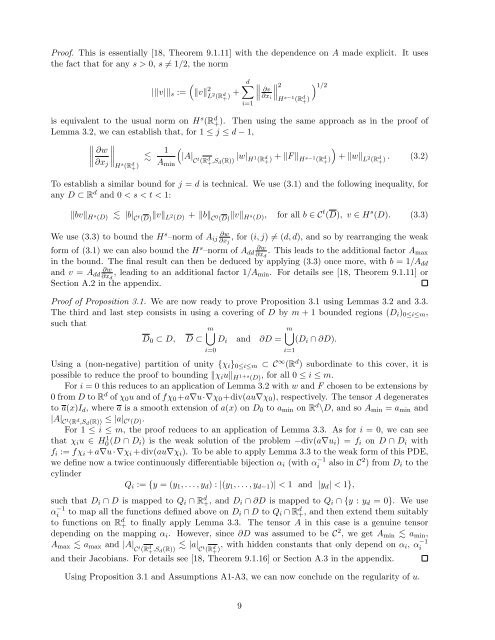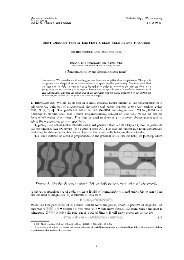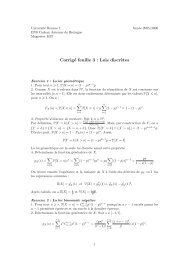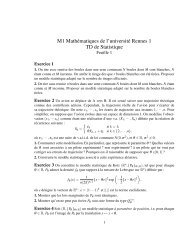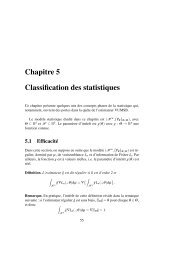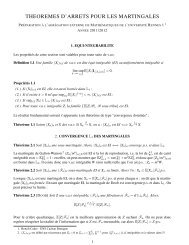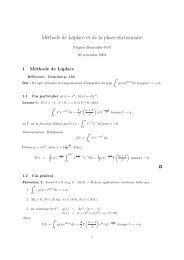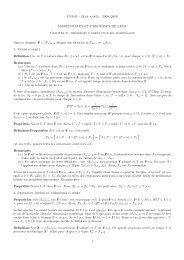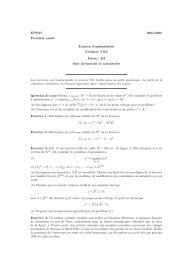Bath Institute For Complex Systems - ENS de Cachan - Antenne de ...
Bath Institute For Complex Systems - ENS de Cachan - Antenne de ...
Bath Institute For Complex Systems - ENS de Cachan - Antenne de ...
You also want an ePaper? Increase the reach of your titles
YUMPU automatically turns print PDFs into web optimized ePapers that Google loves.
Proof. This is essentially [18, Theorem 9.1.11] with the <strong>de</strong>pen<strong>de</strong>nce on A ma<strong>de</strong> explicit. It usesthe fact that for any s > 0, s ≠ 1/2, the normd∑∥|||v||| s :=(‖v‖ 2 L 2 (R d + ) + ∥ ∂v ∥∥2∂x ii=1H s−1 (R d + ) ) 1/2is equivalent to the usual norm on H s (R d +). Then using the same approach as in the proof ofLemma 3.2, we can establish that, for 1 ≤ j ≤ d − 1,∥ ∂w ∥∥∥H∥ 1 ()|A|∂x j s (R d + ) A C t (R d min + ,S d(R)) |w| H 1 (R d + ) + ‖F ‖ H s−1 (R d + ) + ‖w‖ L 2 (R d + ) . (3.2)To establish a similar bound for j = d is technical. We use (3.1) and the following inequality, forany D ⊂ R d and 0 < s < t < 1:‖bv‖ H s (D) |b| C t (D) ‖v‖ L 2 (D) + ‖b‖ C 0 (D) ‖v‖ H s (D), for all b ∈ C t (D), v ∈ H s (D). (3.3)We use (3.3) to bound the H s ∂w–norm of A ij ∂x j, for (i, j) ≠ (d, d), and so by rearranging the weakform of (3.1) we can also bound the H s ∂w–norm of A dd ∂x d. This leads to the additional factor A maxin the bound. The final result can then be <strong>de</strong>duced by applying (3.3) once more, with b = 1/A dd∂wand v = A dd ∂x d, leading to an additional factor 1/A min . <strong>For</strong> <strong>de</strong>tails see [18, Theorem 9.1.11] orSection A.2 in the appendix.Proof of Proposition 3.1. We are now ready to prove Proposition 3.1 using Lemmas 3.2 and 3.3.The third and last step consists in using a covering of D by m + 1 boun<strong>de</strong>d regions (D i ) 0≤i≤m ,such thatm⋃m⋃D 0 ⊂ D, D ⊂ D i and ∂D = (D i ∩ ∂D).i=0Using a (non-negative) partition of unity {χ i } 0≤i≤m ⊂ C ∞ (R d ) subordinate to this cover, it ispossible to reduce the proof to bounding ‖χ i u‖ H 1+s (D), for all 0 ≤ i ≤ m.<strong>For</strong> i = 0 this reduces to an application of Lemma 3.2 with w and F chosen to be extensions by0 from D to R d of χ 0 u and of fχ 0 +a∇u·∇χ 0 +div(au∇χ 0 ), respectively. The tensor A <strong>de</strong>generatesto a(x)I d , where a is a smooth extension of a(x) on D 0 to a min on R d \D, and so A min = a min and|A| C t (R d ,S d (R)) ≤ |a| C t (D).<strong>For</strong> 1 ≤ i ≤ m, the proof reduces to an application of Lemma 3.3. As for i = 0, we can seethat χ i u ∈ H0 1(D ∩ D i) is the weak solution of the problem −div(a∇u i ) = f i on D ∩ D i withf i := fχ i + a∇u · ∇χ i + div(au∇χ i ). To be able to apply Lemma 3.3 to the weak form of this PDE,we <strong>de</strong>fine now a twice continuously differentiable bijection α i (with αi−1 also in C 2 ) from D i to thecylin<strong>de</strong>rQ i := {y = (y 1 , . . . , y d ) : |(y 1 , . . . , y d−1 )| < 1 and |y d | < 1},such that D i ∩ D is mapped to Q i ∩ R d +, and D i ∩ ∂D is mapped to Q i ∩ {y : y d = 0}. We useαi−1 to map all the functions <strong>de</strong>fined above on D i ∩ D to Q i ∩ R d +, and then extend them suitablyto functions on R d + to finally apply Lemma 3.3. The tensor A in this case is a genuine tensor<strong>de</strong>pending on the mapping α i . However, since ∂D was assumed to be C 2 , we get A min a min ,A max a max and |A| C t (R d + ,S d(R)) |a| C t (R d ), with hid<strong>de</strong>n constants that only <strong>de</strong>pend on α i, αi−1+and their Jacobians. <strong>For</strong> <strong>de</strong>tails see [18, Theorem 9.1.16] or Section A.3 in the appendix.Using Proposition 3.1 and Assumptions A1-A3, we can now conclu<strong>de</strong> on the regularity of u.i=19


